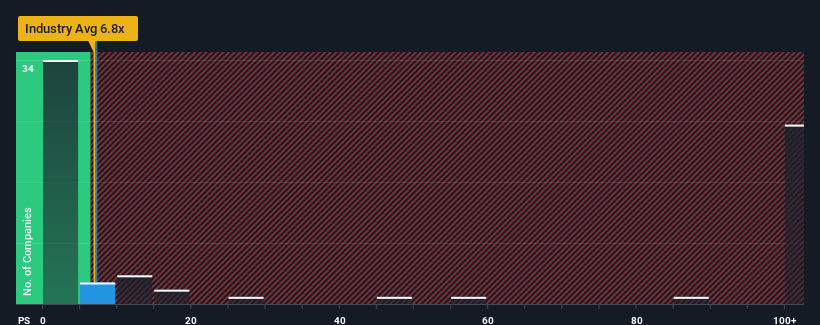- Australia
- /
- Oil and Gas
- /
- ASX:PEN
Why We're Not Concerned About Peninsula Energy Limited's (ASX:PEN) Share Price

With a median price-to-sales (or "P/S") ratio of close to 6.8x in the Oil and Gas industry in Australia, you could be forgiven for feeling indifferent about Peninsula Energy Limited's (ASX:PEN) P/S ratio of 7.2x. While this might not raise any eyebrows, if the P/S ratio is not justified investors could be missing out on a potential opportunity or ignoring looming disappointment.
View our latest analysis for Peninsula Energy

How Has Peninsula Energy Performed Recently?
With revenue growth that's inferior to most other companies of late, Peninsula Energy has been relatively sluggish. Perhaps the market is expecting future revenue performance to lift, which has kept the P/S from declining. If not, then existing shareholders may be a little nervous about the viability of the share price.
Keen to find out how analysts think Peninsula Energy's future stacks up against the industry? In that case, our free report is a great place to start.Is There Some Revenue Growth Forecasted For Peninsula Energy?
There's an inherent assumption that a company should be matching the industry for P/S ratios like Peninsula Energy's to be considered reasonable.
Taking a look back first, we see that the company grew revenue by an impressive 31% last year. Spectacularly, three year revenue growth has ballooned by several orders of magnitude, thanks in part to the last 12 months of revenue growth. Therefore, it's fair to say the revenue growth recently has been superb for the company.
Shifting to the future, estimates from the three analysts covering the company suggest revenue should grow by 58% each year over the next three years. With the industry predicted to deliver 56% growth per annum, the company is positioned for a comparable revenue result.
With this in mind, it makes sense that Peninsula Energy's P/S is closely matching its industry peers. Apparently shareholders are comfortable to simply hold on while the company is keeping a low profile.
The Bottom Line On Peninsula Energy's P/S
Typically, we'd caution against reading too much into price-to-sales ratios when settling on investment decisions, though it can reveal plenty about what other market participants think about the company.
Our look at Peninsula Energy's revenue growth estimates show that its P/S is about what we expect, as both metrics follow closely with the industry averages. At this stage investors feel the potential for an improvement or deterioration in revenue isn't great enough to push P/S in a higher or lower direction. Unless these conditions change, they will continue to support the share price at these levels.
We don't want to rain on the parade too much, but we did also find 2 warning signs for Peninsula Energy that you need to be mindful of.
If companies with solid past earnings growth is up your alley, you may wish to see this free collection of other companies with strong earnings growth and low P/E ratios.
New: Manage All Your Stock Portfolios in One Place
We've created the ultimate portfolio companion for stock investors, and it's free.
• Connect an unlimited number of Portfolios and see your total in one currency
• Be alerted to new Warning Signs or Risks via email or mobile
• Track the Fair Value of your stocks
Have feedback on this article? Concerned about the content? Get in touch with us directly. Alternatively, email editorial-team (at) simplywallst.com.
This article by Simply Wall St is general in nature. We provide commentary based on historical data and analyst forecasts only using an unbiased methodology and our articles are not intended to be financial advice. It does not constitute a recommendation to buy or sell any stock, and does not take account of your objectives, or your financial situation. We aim to bring you long-term focused analysis driven by fundamental data. Note that our analysis may not factor in the latest price-sensitive company announcements or qualitative material. Simply Wall St has no position in any stocks mentioned.
About ASX:PEN
Peninsula Energy
Operates as a uranium exploration company in the United States.
Exceptional growth potential and good value.
Similar Companies
Market Insights
Community Narratives



